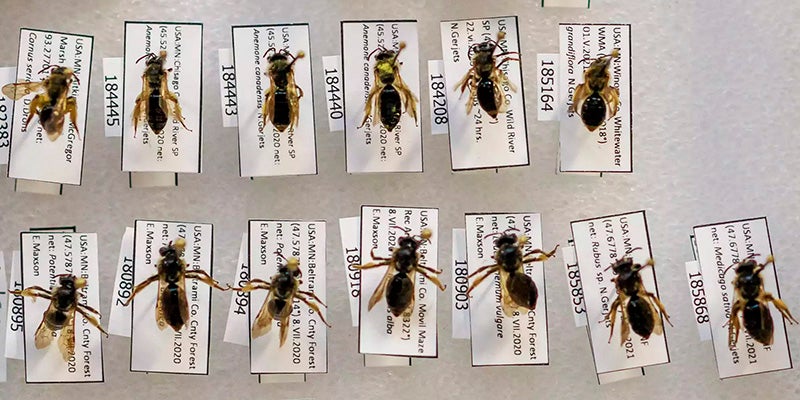Buzzz! New research finds more than 500 bees native to Minnesota
Published 6:12 pm Tuesday, February 7, 2023

- Bees collected by researchers are stored at the Minnesota Department of Natural Resources in St. Paul on Jan. 19. Tags indicate where the bees were captured and their scientific name.Kerem Yücel | MPR News
|
Getting your Trinity Audio player ready...
|
By Dan Gunderson
Minnesota has a very diverse native bee population. New research has compiled the first comprehensive list of more than 500 species of bees native to Minnesota.
Native bees in Minnesota range from the large, easy to spot bumble bee, to dozens of species so tiny they are hard to see with the naked eye.
Some bees are known as generalists, they collect pollen and nectar from a variety of plants.
Others are specialists, dependent on a single species of flowering plant.
“Some examples would be a trout lily specialist and a spring beauty specialist,” explained Minnesota Department of Natural Resources bee survey expert Nicole Gerjets.
“They’re only out when those spring ephemerals, those spring beauties and the trout lilies are blooming.”
So researchers will never see the specialist bees if they don’t visit those flowers while they are in bloom. Another hard to find example is the pickerel bee.
“There was only one historical specimen of that for Minnesota,” said Gerjets who shares a workspace with hundreds of preserved bees carefully classified and stored in large cabinets.
The pickerelweed is an aquatic plant. So researchers went to known pickerelweed patches while they were blooming last summer.
“And we were super successful,” exclaimed Gerjets. “Often times at some of those sites that we would go to, we would see that bee flying everywhere around that whole patch of pickerelweed. That was a really exciting find.”
Bee census
There was a bee survey in Minnesota in 1919, but it was never intended to be all encompassing and listed just 66 species.
The work to create the definitive list of bees native to Minnesota started in 2014 with a grant from the Minnesota Environment and Natural Resources Trust Fund to the Minnesota Biological Survey.
Ever since, researchers have been poring over regional museum insect collections and traveling across the state in search of live bees on a variety of landscapes. The project ends in June.
Gerjets spends the winter months hunched over a microscope trying to identify all the bees found during summer searches across the state.
“Some of these bees are very, very, very tiny,” she said. “You do have to look under a microscope to be able to identify them.”
Rather than pin them to a board for preservation and display, the tiny bees are glued to the head of the pin, because the pin is larger than the bees body.
Sorting the species
The science of categorizing bees is challenging because many look very similar, said Zach Portman, a research scientist in the University of Minnesota’s Cariveau Native Bee Lab. He estimates he’s identified about 200,000 bee specimens in the past 13 years.
Portman is working with the DNR and is leading a project to publish the definitive list of native bees in Minnesota.
Minnesota has more bees than many eastern states according to Portman, because it’s located at the intersection of several ecoregions. We are home to primarily eastern bee species, but also has western, northern and southern species.
Identifying bees and other organisms is a science called taxonomy. It requires methodically working step-by-step to check many bee characteristics from the number and size of teeth on the jaw, or mandible, to the location of pollen collecting hairs and of course color and size.
It might sound tedious and boring, but it’s actually quite important, said Portman.
And at times, it can be perplexing.
“We have a lot of undescribed species and we have a lot of what are called ‘cryptic species complexes’ where what has generally been thought of as a single species is actually a group of similar related species,” said Portman. “And so figuring them out can be a big challenge.”
After the bees are identified, they are stored at the University of Minnesota Insect Collection, one of the largest in North America. There they will be available for present and future generations of scientists.
Much more to study
Proper identification lays the groundwork for a basic understanding of a species. It helps determine which bees might be at risk of population decline, and can help scientists decide which wild bees need more research.
“There are species that there’s been enough research on, specifically bumble bees, to tell us that some species are declining, some are stable and some are doing really well these days,” said Gerjets.
But with hundreds of native species, there are many that scientists know very little about.
“One of the tough parts with bees and bee declines in general is that there are so many species, if you try and know everything about all of them, it’s simply too much,” said Portman.
The list of more than 500 native bee species is only a baseline for future research. Some of the museum specimens on the list were collected decades ago. In some cases researchers found the same species in the field. Others were not found.
“We don’t know if we have just missed them, Minnesota might be on the edge of their range, or they might be of conservation concern,” explained Gerjets.
Researchers have some ideas about which bee species might most need conservation protections.
Minnesota has lost most of the native prairie that once existed in broad swaths across the western part of the state. While researchers can’t recreate those conditions, the loss of prairie likely led to the loss of some bee species dependent on prairie plants.
“Some species are probably much more vulnerable,” said Gerjets, “Especially these specialists that really rely on those (specific) plants. And if those plants or that habitat goes away then they will also go away.”
While understanding the needs of more than 500 species of bees might seem daunting, Portman said in general, helping native bees is not complicated.
“It’s pretty straightforward. They need undisturbed habitats, a lot of good floral resources, no pesticides. And if you give them that stuff, most species, really they thrive,” he said.
And Portman also has some simple advice for people who want to see more of the bee diversity in Minnesota.
“If you slow down and you pay attention and you watch flowers, you’ll very quickly see a lot of bees that you never noticed before.”




